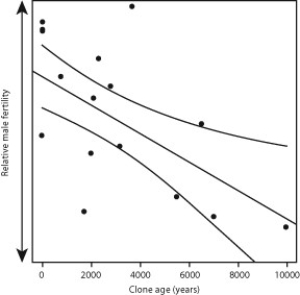Plants differ from many animals because they undergo indeterminate (continual) growth. Indeterminate growth is common in clonal plants because a single clone can continually produce new clones without undergoing sexual reproduction, even if the plant is capable of doing so.
Senescence, an inability to undergo cell division as an organism ages, also occurs in many plants and animals. However, scientists have had a difficult time establishing the occurrence of senescence in cloning plants because of their indeterminate growth patterns. Mutations in somatic cells are common during asexual growth, and these mutations lead to a decrease in sexual fitness. Scientists hypothesize that over time, as these mutations accumulate, they may contribute to senescence in clonal plants. To test this theory, scientists studied a naturally growing population of trembling aspen (Populus tremuloides) , a tree species that grows clones from its root system but is capable of sexual reproduction. To determine if trembling aspens senesce, they compared genetic data of estimated tree age with the variable of "diminishing fertility": the amount of pollen released by male aspen trees. Here are the results for this part of the study:
 Source: Adapted from Ally, D., Ritland, K., & Otto, S. P. (2010) . Aging in a long-lived clonal tree. PLoS Biol, 8(8) : e1000454. doi:10.1371/journal.pbio.1000454.
Source: Adapted from Ally, D., Ritland, K., & Otto, S. P. (2010) . Aging in a long-lived clonal tree. PLoS Biol, 8(8) : e1000454. doi:10.1371/journal.pbio.1000454.
-If a male trembling aspen clone loses its ability to produce pollen, how is its reproduction capability affected?
Definitions:
Subjective Well-Being
Someone's self-evaluation concerning their overall happiness and life fulfillment.
Epinephrine
A hormone also known as adrenaline, secreted in response to stress and increases heart rate, muscle strength, blood pressure, and sugar metabolism.
Lymphocyte Activity
The functions and behaviors of lymphocytes, a type of white blood cell, in the immune response to protect the body from foreign substances.
Perceived Control
An individual's belief or perception regarding the extent to which they can influence or predict outcomes in their environment.
Q6: From which part of this figure will
Q7: Which statement regarding endocrine glands is true?<br>A)
Q16: Suppose that scientists who study predator-prey relationships
Q23: Where do plants get most of their
Q36: Part B indicates that<br>A) nontreated males were
Q47: Two important contributions that cleavage makes to
Q49: Forest destruction reduces the magnitude of impacts
Q51: Which process does not occur in ecosystems?<br>A)
Q62: Which of the following processes dominates the
Q87: Which of the following STIs is caused